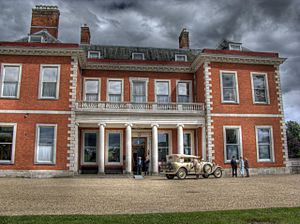James Whitelocke facts for kids
Sir James Whitelocke (1570–1632) was a well-known English judge and politician. He was a Serjeant-at-law, a special kind of senior lawyer. Sir James served in the House of Commons, which is a part of England's Parliament, from 1610 to 1622. He was known for standing up for the rights of the people against the king.
Contents
Early Life and Education
James Whitelocke was born in London in 1570. He was one of two twin sons born after his father, Richard Whitelocke, had passed away. His mother was Joan Brockhurst.
From 1575, James went to Merchant Taylors' School. Later, in 1588, he went to St. John's College, Oxford. He became a fellow there in 1589. He studied many subjects, including classics, law, and even Hebrew. He earned his degree in civil law in 1594. During his time at Oxford, he made friends with people who would become important later, like William Laud.
After Oxford, James studied law at the Middle Temple in London. He became a lawyer in 1600.
A Career in Law and Politics
James Whitelocke began his career by managing estates for St. John's College in 1601. He became the recorder (a legal officer) for Woodstock in 1606. He also worked as a legal advisor for Eton College.
In 1610, Whitelocke was elected as a Member of Parliament (MP) for Woodstock. In Parliament, he spoke about important issues. He often defended the rights of ordinary people. He also spoke about limiting the king's special powers, known as the royal prerogative.
This made him popular with the public but caused problems with the king. In 1613, he was put in Fleet Prison for a short time. This happened because he questioned the king's power to investigate the navy. He was released after he agreed to apologize in writing.
In 1614, he was re-elected as an MP for Woodstock. He continued to speak out. The Parliament was quickly closed by the king. Whitelocke and other MPs were told to destroy their notes from the debates.
Despite these challenges, his reputation as a lawyer grew. In 1616, he bought a large estate called Fawley Court in Buckinghamshire. He was also appointed to important local legal roles. For example, he became a justice of the peace for Buckinghamshire.
In 1620, James Whitelocke became a serjeant-at-law, a very senior lawyer. He was then appointed Chief Justice of Chester. This was a very important legal position. He was also knighted, becoming Sir James Whitelocke. Later, in 1624, he became a justice in the King's Bench, one of England's highest courts. He also heard cases in the Chancery and the Star-Chamber. He was re-elected MP for Woodstock in 1621.
Standing Up to the King
When King Charles I came to power, Sir James Whitelocke continued his work. In 1625, during a serious outbreak of the plague, he had to quickly adjourn (pause) the court. He traveled safely to Westminster Hall to do this important duty.
In 1626, Sir James and another judge refused to say that forced loans by the king were legal. This showed his independence. However, in a later case, he supported the Crown's decision to hold some prisoners. This led to the judges being questioned by the House of Lords.
In 1629, Parliament questioned the release of some suspected Jesuits. Sir James, as one of the judges, explained that there was no proof they were priests. Later, when some MPs were arrested, Sir James and other judges were asked for their legal opinion. They tried to avoid directly answering the king's questions. Sir James did agree to the release of the prisoners if they promised good behavior, but they refused.
Sir James Whitelocke was also very interested in old books and history. He wrote several papers on these topics. His personal journal, called Liber famelicus, was published after his death.
Sir James Whitelocke passed away at Fawley Court on June 22, 1632. He was buried in Fawley churchyard.
His Family
In 1602, Sir James Whitelocke married Elizabeth Bulstrode. She was from a well-known family in Buckinghamshire. Two of her sisters, Dorothy and Cecily, worked for Queen Anne of Denmark.
Sir James and Elizabeth had several children. Their eldest son was Bulstrode Whitelocke (born 1605), who also became an important politician. Their son James was born in 1612. Their daughter Elizabeth was born in 1603. They also had daughters named Mary, Cecilia, and Dorothy, and another daughter named Joan.
Sir James also had a twin brother named William. William served under the famous explorer Francis Drake and died at sea fighting the Spanish. Another brother, Edmund, was a courtier.
Books
- Powell, Damian X., Sir James Whitelocke's Liber Famelicus, 1570–1632. Peter Lang AG, 2000. ISBN: 0-8204-4637-8.



